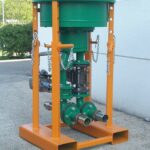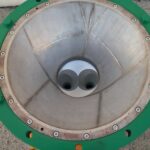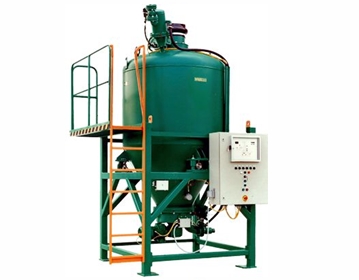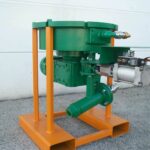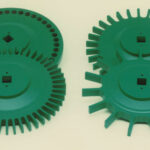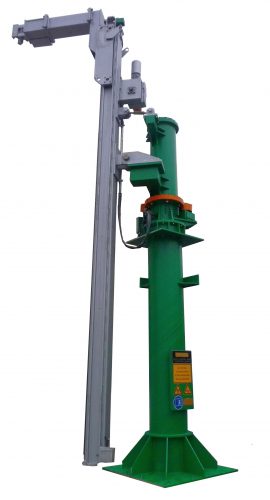Conveying technique

Injection machines
At the pneumatic conveyance of bulk materials it is distinguished between thin-, mixed- and dense stream conveyance. The dense stream conveyance has the advantage of high material load what leads to low material speed. This has positive effect on the wear of the conveying line and reduces maintenance and operational costs. VELCO machines can convey diverse bulk materials as for instance carbon, lime, additives, DRI but even filter dust.
UNIDOS

The UNIDOS is provided with a new and patented discharge system. The bulk material is dispersed and afterwards discharged in the so-called thin-, mixed- or dense stream method.
The UNIDOS is provided with a new and patented discharge system. The bulk material is dispersed and afterwards discharged in the so-called thin-, mixed- or dense stream method.
This system allows the constant conveying and dosing of dry bulk materials with a grain size between 0 and 8 mm. The UNIDOS machine can be equipped with several outlets for the continuous conveyance into several conveying lines.
A special feature is that each outlet can be controlled separately.
The vessel volumes can be between 0,5 and 5 m³.
UNIDOS-R
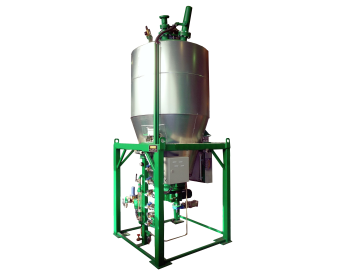
- Injection machine with a volume of 1,2m³
- Pre-container with a volume of 2,4m³ with vibrating sieve
- Automatic filling of injection machine UNIDOS-R 1,2 Twin
- Weighing system type Siemens SIWAREX CS
- Control cabinet with operation panel, type Siemens TP177 and SPS S7-300
- Remote control with 20 m of control cable
- Adjustable conveying capacity (top pressure regulation)
- Total weight: 2115 kg´s
VELCO developed the injection machine UNIDOS-R especially for bad flowing and agglomerating bulk materials.
On the basis of the well-proven UNIDOS basic model the UNIDOS-R is equipped with a special substructure that have an aeration bottom and an electrically driven stirring unit. This machine is mainly used for the following applications:
- Disposal of blast furnace flue dust, filter dusts and other steelplants’ residues by injection into the blast furnace. This reduces the operational costs and saves additional costs for waste disposal sites.
- Injection of ironmongery and small sections serve as cost-saving substitutes for iron ore.
- Injection of titaniferous sandstone ore (ilmenite) or synthetic titanium carrier (Rutilit – trade name of VENATOR (vormals Sachtleben Chemie GmbH, Duisburg)) into the blast furnace. This leads to an increased service life of the hearth and the furnace walls.
- Injection of carbon and alloy carriers into shaft furnaces for a quick correction of the iron melt.
In all cases the materials are injected via the tuyeres into the furnace. In case of titanium carriers the material can be fed to the areas to be protected during normal operation. Only few conveying lines are required.
The highest demands are put on the injection installation when processing filter dusts, since these are very cohesive and thus difficult to handle, due to their fineness, suppleness and high share of zinc (up to 30%). This requires a high degree of flexible working conditions, with variable injection rates that may reach from high values up to lower ones as for instance 1 kg/min. All these requirements are fulfilled only by one machine type.
The injection machine EKS-K consists of a pressure vessel with a volume of 0,5 – 5,0 m³ that is filled via an automatic filling lock system. The materials discharge is effected through a mechanical dosing system.
The latter consists of a motor-powered flow impeller that doses the injection material to the blow-off socket. This allows an even material flow even in case of difficult conveying materials such as humid carbon or filter dusts.
Depending on the bulk material and the line’s cross section the conveying capacity can be between 2 and 200 kg/min.
The chamber substructure can be equipped with up to 3 outlets, which allow an even conveyance at several injection points (e.g. for several blast furnace tuyeres or side lances at the EAF). A weighing system can be installed for the recording of consumption rates.
The adjustment of the conveying capacity can either be remote controlled by regulation of the chamber pressure or by changing the speed of the flow impeller.
EDS-K

Injection manipulator - LMI
The lance manipulator of type LMI 58 inserts the monolithic injection lance required for the melting bath injection into the raw iron melt.
The lance manipulator consists of the following structural components:
- Support with base plate for mounting the lance manipulator on the working platform
- Tower with drive for swivelling of the lance manipulator for receipt of guide column
- Traverse with clamping arm for receipt of the monolithic injection lance
DOSING SYSTEM
Would you like individual advice on our conveyor technology?
